Paludarium keepers know that sometimes you can really have it all. Most pet keepers try choosing between the worlds of land and water. They set up an aquarium (water-only) or a terrarium (land-only).
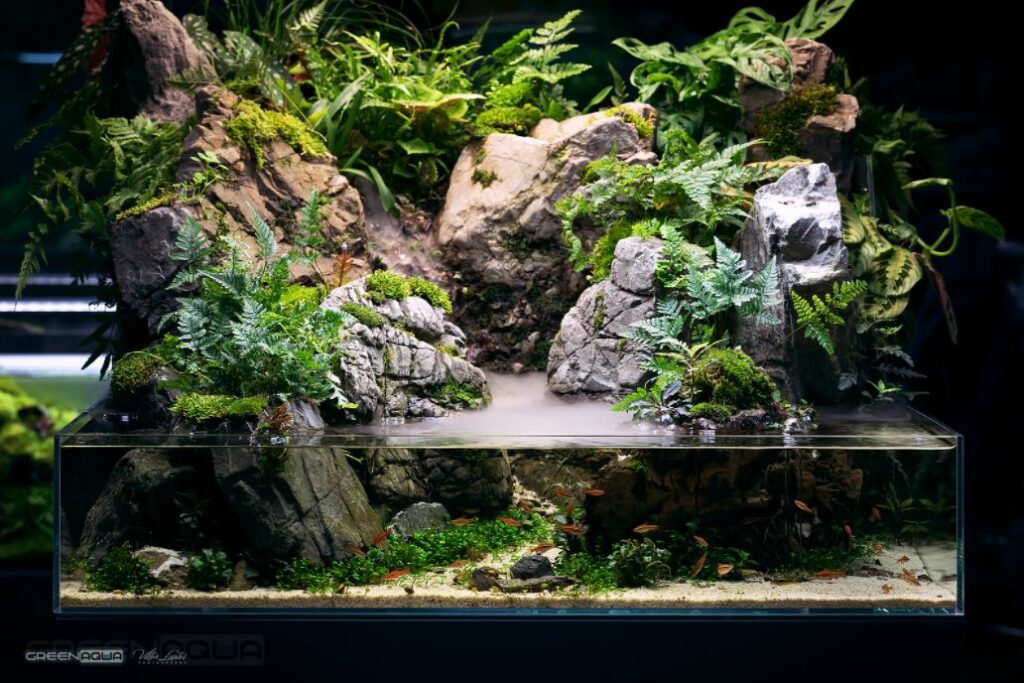
But a paludarium allows you to have both land and water in a single enclosure. It also means that you can mix semi-aquatic plant species, aquatic animals, and terrestrial plants and animals together for a display like no other.
So what is a paludarium and how can we set one up?
What is a Paludarium?
A paludarium tank is designed to replicate the natural environment of forest-dwelling animals that also rely on water. A rainforest is the closest analogue to what a paludarium is.
Each of the best designs is built around the concept of layers. The lowest layer is the water portion. Here is where aquatic species like fish and true aquatic plants will spend all of their time. You can also add semi-aquatic animals like frogs, salamanders, and crabs that will crawl in and out of the water. So long as they are all compatible, of course (see below).
The second layer is the land portion. How much land area you decide to create depends entirely on your creative whims as well as the kind of terrestrial animals you decide to go with. If you enjoy turtles and other reptiles that need flat basking surfaces then you will need a larger land portion.
Last is the aerial canopy layer. This replicates the tangle of trees, branches, and other plant life that occupies the zone above the land space and water section. You have even more freedom to be creative here and can include canopy dwellers like lizards, snakes, dart frogs, or jumping spiders.
But some tank owners decide not to add many animals that live in this layer since having every zone occupied can complicate caring for the setup.
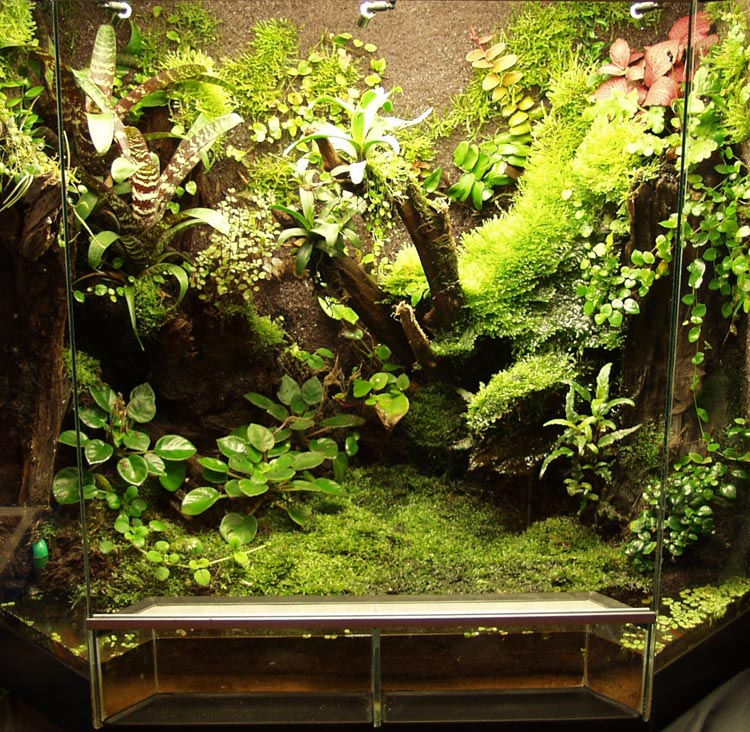
Why Should I Consider Paludarium Ideas?
When creating your own setup it can often feel a little overwhelming at first. There is a lot of data out there on how to take aquariums and convert them to land-water setups. So one of the best ways to begin is to look into what other people have done already.
I recommend collecting images that fit the theme you have in mind on Pinterest and other boards. You can see what resonates with you the most and start designing your personal paludarium to fit this mold.
Do you prefer aquariums with rocks and driftwood? A more hardscape-oriented setup? Or are designs where the water level is very high what you’re looking for; a space for mostly aquatic species? There are thousands of successful setups you can browse and no way to get it wrong, so spend some time browsing the endless array of options online before committing to your design.
How to Build a Paludarium
Once you have settled onto a basic design, it’s time to start putting together your paludarium. All that’s required is an aquarium and a lot of imagination.
Exo Terra and ZooMed Paludarium Tanks
Let me first point out that these days you don’t have to build a paludarium tank entirely from scratch. Many companies offer up small to large paludarium designs that come in any desired shape and layout.
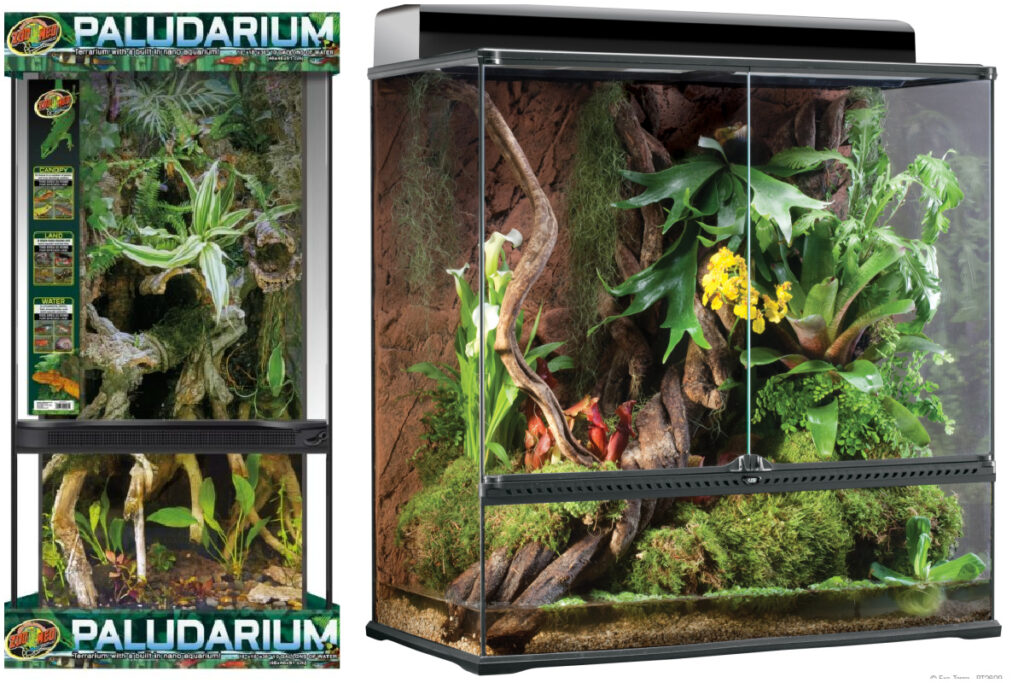
Zoo Med is by far the most popular of these. Within mere minutes you can have one up and running, complete with a back wall customized to your desired effect. A typical Zoo Med paludarium has room for both plastic and other plants. Niches along the back wall allow you to attach creeping plants like a creeping fig or pothos.
The front glass opens and closes from the front as well, making maintenance significantly easier. And by sealing the tank entirely you create a high degree of humidity, which paludarium plants and animals prefer. In such humid environments, you will see plants positively explode in growth compared to the dry air of the average home.
Some models also include a floating shelf made of an aquarium-safe material in the same tank. This little bit of extra land area allows basking animals to get a respite without crowding the land portion of the paludarium.
I am also a big fan of the Exo Terra Paludarium lineup. Each one is elegantly crafted and offers a lot more space for you to customize how nature is expressed inside your vivarium. Zoo Med and Exo Terra Paludairum designs do cost more than building your own custom setup but not by that much.
Each tank is already ready for inhabitants to make their homes within. And you get a professional and polished look right from the beginning instead of having to experiment a whole lot. Many find the added cost to be well worth it.
Paludarium Plants
Picking aquatic plants for a paludarium is also fun because the shallow water portion means you have a chance of seeing emersed growth. Emersed growth is when the plant breaks the water’s surface and continues to grow upward. In an aquarium, you rarely see this since the plant gets trimmed back or reaches maximum height before breaking the water’s surface.
But in a paludarium, you have a chance to see how different aquatic plants grow unique leaves in the air. Many will also flower or take on different colors than you are used to. Many plants that are considered aquatic are actually amphibious and do equally well in a paludarium so long as they are kept moist. Aquarium favorites like Java Fern, Anubias, mosses, Moneywort, and Hygrophila species will all thrive here, just to name a few.
Many plants considered to be true terrestrial plants will also love the warm, moist environment of a paludarium. Pothos can be found in stores around the world and they will explode in growth when placed in a paludarium.
Paludarium Animals
When choosing animals to live in a paludarium the first choices to consider are semi-aquatic creatures. These animals will find all of the aquarium safe since they are not at risk of drowning or drying out if they get stuck in one zone or another.
Animals that live in a semi-aquatic habitat include frogs, salamanders, fiddler crabs, aquatic turtles, and many snakes that enjoy swimming. But be very careful in which animals you choose to mix. Turtles, for example, are opportunists that will eat anything they catch, including any slow and small animal sharing the paludarium.
Aquatic Animals
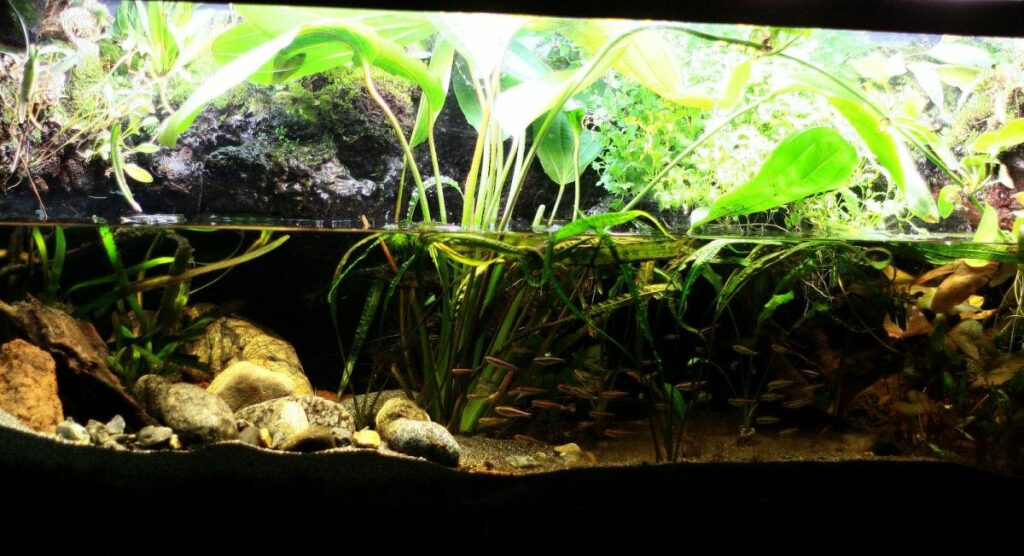
When adding animals to a paludarium aquatic animals are a popular place to start looking for options. There is a wide array of possibilities, including fish, amphibians, reptiles, and invertebrates. What is most important is to choose animals that are compatible with each other. As much as you might like to house turtles and fish together, you are asking for trouble more often than not.
- Fish: endless variety; limited only by tank size and compatibility
- Snails
- Crabs
- Turtles
- Frogs
- Salamanders
Semi-aquatic Animals
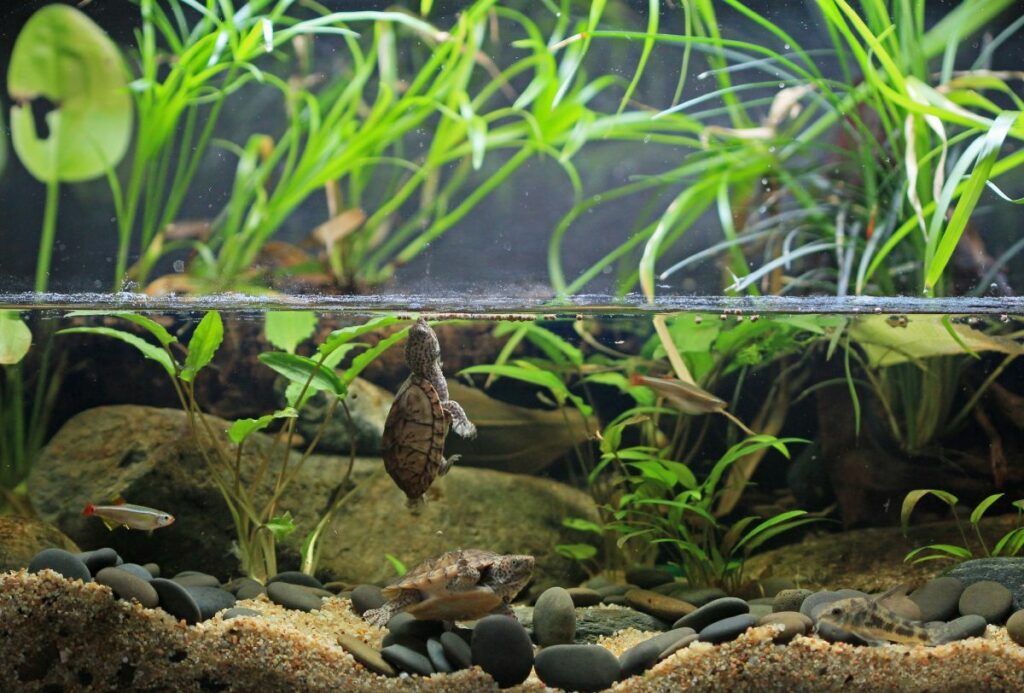
Semi-aquatic animals live in the transition zone between land and water. They need easy access to both areas as a result and should not be trapped between land and water.
- Mudskippers
- Fiddler Crabs
- Most Frogs
- Aquatic Turtles
- Certain Lizards (Water Dragons) and Snakes
Canopy Animals
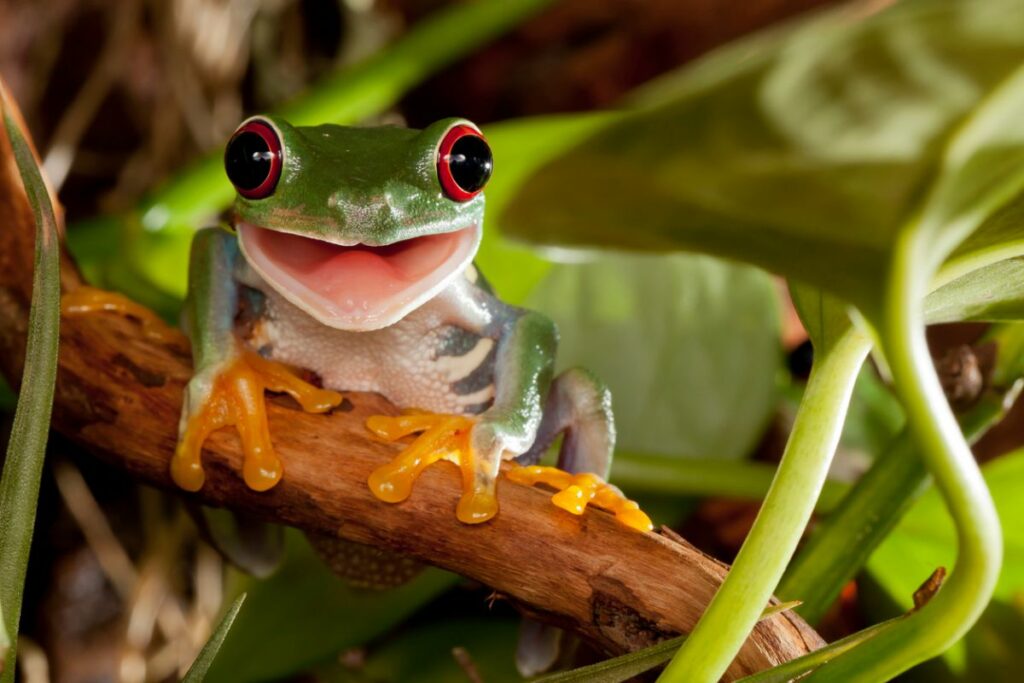
Animals that live above the ground and water again need to be carefully chosen. If they are unable to swim then your water zone should be very shallow or not directly under any plant branches.
- Anoles and other Arboreal Lizards
- Arboreal Frogs
- Jumping Spiders
- Arboreal Snakes
Nano Paludarium Tanks
Just because most paludairums house animals in medium to large tanks does not mean that you have to follow suit. Some of the most beautiful setups are nano paludariums, which can be as small as a few hundred milliliters in volume.
Nano paludariums also have the advantage of being a lot less complicated to maintain and significantly less expensive than a larger setup. Do be aware that they offer far less space for plants and animals, though.
There are basically no terrestrial animals that would work well in nano paludariums except for insects and other invertebrates. As far as terrestrial plants go, mosses, creeping plants, and small seedlings can work very nicely in a nano setup.
You have plenty of flexibility where aquatic life is concerned, however. Plenty of fish and invertebrates like shrimp and snails are tiny enough to live comfortably inside of a smaller tank.
Choosing Decorations for a Paludarium Tank
Besides aquatic and semi-aquatic plants, you should also look into traditional hardscape additions that you would use for a regular aquarium.
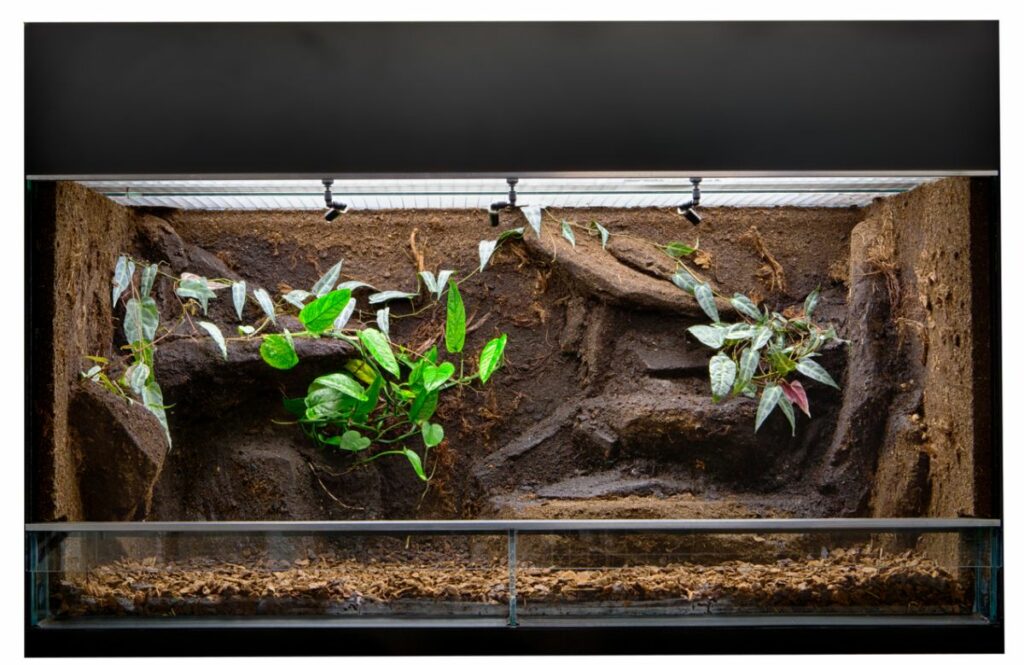
Rocks are a popular choice and can be placed within the water or without. Just be careful to only choose rocks that won’t negatively affect your tank’s water chemistry. Some, such as seiryu rocks, are known to be water safe and won’t leach high levels of minerals.
Others, such as limestone and sandstone, look pretty but will cause the pH and hardness to rise over time. As a general rule, sedimentary rocks usually have an effect on water chemistry. Metamorphic rocks usually do not. And igneous rocks can go either way – so do a little research if you have an unknown rock you want to use for decoration.
Wood in the form of driftwood is another great choice in decorations. You can wrap semi-aquatic plant species around it and semi-aquatic animals will use it as a place to rest. Wood does slow-release tannins, which have a pH-reducing effect. But it’s fairly mild and depends more on the kind of wood you add to your paludarium.
And if you are keeping carnivorous plants they actually require acidic environments anyway. So using driftwood is doing them a favor.
Just keep in mind that wood tends to rot faster in a semi-aquatic environment. Exposed to both water and air, it can also develop fungus. Most fungi are ugly but harmless. However, they can cause problems if they take over and start releasing spores to infect other sections of wet organic material inside your paludarium.
DIY Paludarium Rear Wall
Something you rarely see in a regular aquarium are foam backgrounds. Occasionally they are custom built by aquarists looking to create a rocky wall that simulates a cave or riverbank. However, you can often find paludarium designs that replicate a swamp look using them. Or you can very easily craft your own using foam sealant.
This one and other videos do an excellent job of demonstrating how to craft a foam rear wall, from application to painting. Do be aware that not all foams are aquarium safe. You need one that won’t leech toxic chemicals after it is cured into the surrounding water. Fortunately, there are quite a few that work very nicely for creative terrarium and paludarium construction.
Building Shelves Using Paludarium Egg Crate
Assuming you have decided to build your own paludarium design, one of the best tools available is sections of egg crate. Egg crate is lightweight yet capable of holding a substantial amount of weight.
You can also cut it to fit nearly any location within the aquarium. With it, you can build islands for the inhabitants to sit on, platforms along the water area for plant species, and so on. The holes are too wide for soil but egg crate can be easily covered with peat moss, foam, or other substances.
It is also very useful as a guard for filters and heaters; delicate equipment that can be knocked around or broken by the vivarium inhabitants. Last, it can also form a solid platform to continue building off of.
Egg crate is made of PVC, which can be safely immersed below the water level without fear of nasty chemicals leaching out from it.
Maintaining Humidity in a Paludarium
Humidity is very important when keeping paludariums, especially setups with tropical plants that need a lot of moisture.
Fortunately, paludariums tend to be very good at maintaining humidity all on their own. The large pool of water along the bottom will evaporate continuously, adding to moisture levels. Paludariums that are well-sealed and rarely opened except for maintenance will also retain moisture better than a tank open at the top or one that is constantly being opened.
Some terrarium and paludarium-keepers mist their setups. But I recommend using a mister that has been installed inside of the tank and runs on a timer. This way humidity remains continually high and you don’t lose moisture by opening the tank.
Last, the plants that you add will also help maintain humidity. The soil and peat moss they grow in requires water, which will be slowly released into the surrounding air. Plants also transpire, releasing water into the surrounding air.
Setting Up a Paludarium Waterfall
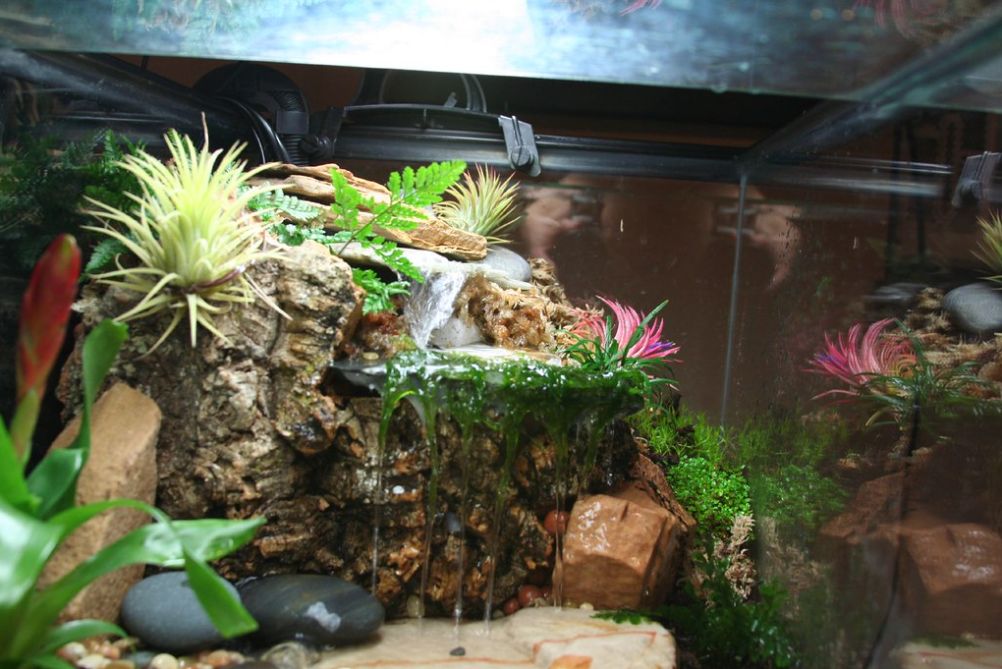
While paludariums have a lot of passive ways to maintain humidity you can also use the decor in your favor. One of the most popular ways to keep the humidity high is to set up a waterfall within the tank.
A paludarium waterfall is always a striking center point for the entire setup. It provides a splash zone for semi-aquatic plants and animals to thrive. And by running water from the top of the tank to the bottom humidity levels are better equalized throughout the setup.
All that is required for a waterfall is a pump to pull water from the lowest levels and a channel to run it through. If you are designing a rear wall using spray foam, it is easy to mold a waterfall channel in the process. And if you spray the foam around the piping running from pump to outlet, you can securely house the waterfall setup in place.
Many pre-fabricated paludairums made by Zoo Med and Exo Terra also have spaces for pumps to be installed and channels for water flow built into them. All you need to do then is fill up the setup and you can have your waterfall running in mere minutes.
In Conclusion
Paludariums are ideal for folks who love both land and water setups and want to try setting up a tank with both elements. It can be the closest thing to a thriving ecosystem to watch in the comfort of your own home. And few settings allow you to so thoroughly mix plant and animal species together as paludariums do. While they take more research to get up and running they might just be the most fun you can have in a single tank.
More Frequently Asked Questions about Paludariums
This guide has been an in-depth look at caring for paludariums. But in case you’re curious to learn more, here are a few more frequently asked questions about them.
A vivarium is any tank setup that allows animals and plants to live in. A terrarium and an aquarium are both types of vivariums, as are paludariums. But a paludarium is specifically a vivarium tank designed to create space for both aquatic and terrestrial species to coexist.
Paludariums allow you to mix plant and animal species together. You can even sort them by zones, where canopy, land, and water areas all have fish, reptiles, plants, and amphibians that thrive in these areas.
Starting paludariums need not be complicated or expensive. It can be as simple as buying a prefabricated setup. Or as complex as building your own from scratch. The limit is only your own imagination.

